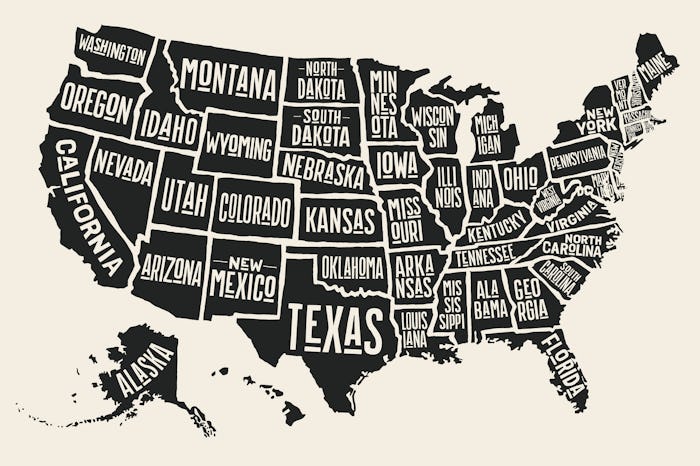Life
These Are The States With The Most Flu-Related Child Fatalities So Far
This year's flu season might not be the worst ever on record, but it has been a particularly nasty one — and unfortunately, it just keeps on getting nastier. If You're a parent, your child is your top priority and you might be wondering: Where are the most kids dying from the flu? The Centers for Disease Control and Prevention (CDC) reported that (as of last week), the number of states experiencing “high” influenza activity spiked from from 26 to 32 states (plus New York City and Puerto Rico). Even worse, a total of 37 children have died from flu-related illnesses so far this year. These numbers are terrifying.
The CDC doesn't have specific data on pediatric flu deaths by state (and the truth is, those numbers are changing by the day, anyway). They do, however, know that all U.S. states except for Hawaii are continuing to report widespread influenza-like-illness (ILI) activity, and some of those states are having more serious problems than others. Here are the states, organized by the amount of flu-related activity they are witnessing:
High ILI Activity: Alabama, Arizona, Arkansas, California, Florida, Georgia, Hawaii, Illinois, Indiana, Kansas, Kentucky, Louisiana, Maryland, Mississippi, Missouri, Nebraska, Nevada, New Jersey, New Mexico, New York, North Carolina, Ohio, Oklahoma, Oregon, South Carolina, South Dakota, Tennessee, Texas, Virginia, West Virginia, Wisconsin, and Wyoming.
Moderate ILI Activity: Alaska, Colorado, Idaho, Iowa, Massachusetts, Minnesota, North Dakota, Pennsylvania, and Rhode Island.
Low ILI Activity: District of Columbia, Connecticut, Michigan, New Hampshire, Utah, Vermont, and Washington.
Minimal ILI Activity: Delaware, Maine, and Montana.
Because not all states report pediatric flu deaths separately from adult deaths, the details of where the most kids are contracting fatal cases aren't absolutely clear. The CDC does, however, have an interactive map breaking down pediatric flu deaths by HHS (health and human services) regions, which reveals the areas of the country where children have been hit the hardest. The darker the state, the higher the number of fatalities.
From analyzing this graphic we can see that the most influenza-associated pediatric deaths have occurred in the Southwest, West, Northwest and Alaska (at a rate of 0.6 to 1.5 per 1,000,000 children). The Northeast, Southeast and Midwest, meanwhile, seem to be faring better (at a rate of 0 to 0.5 kids per million). And while, again, official state-by-state numbers aren't available, there is solid info from some locations. The following state departments have reported three pediatric deaths so far:
- The Arizona Department of Health
- The Kentucky Department for Public Health
- The Ohio Department of Health
- The Texas Department of Health Services
Those numbers might not seem staggering, but of course no child should have to die from the flu — and when you look at how the stats are stacking up this season compared to other years, the big picture starts looking a little bit scarier:
While hopefully this year won't be quite as fatal for kids as, say, 2014-2015 turned out to be, we're not out of the woods quite yet (it's only January, remember). And, as you might have heard, this year's vaccine isn't as effective as experts hoped it would be: While this season's most pervasive strain of flu is H3N2 (also an especially serious strain), The New York Times reported that this year's vaccine is most effective against the H1N1 strain. Sigh.
Of course, that doesn't mean you shouldn't still get the flu shot (or get your child the flu shot, as the case may be) — and it's not too late, either, according to the Food and Drug Administration (FDA). That said, the CDC warns that it does take about two weeks after vaccination for the antibodies to develop in the body that protect against the flu... so the sooner, the better.
And bear in mind, just because your state isn't in one of the regions on the map that looks to be in more trouble than the others doesn't mean your family is in the clear. For example, I live in Connecticut, which is one of the states reporting "low" ILI activity, but a 10-year-old boy in New Canaan passed away this month from complications related to the flu. So there's truly no way of knowing where and when this deadly virus will hit, and how its victims, young children and the elderly especially, will respond to it.
Flu season peaks between December and February, according to the CDC, but can hang on until as late as May, so keep washing those hands and be on the lookout for symptoms for the foreseeable future!
With Additional Reporting By Emily Westbrooks.
Check out Romper's new video series, Romper's Doula Diaries:
Watch full episodes of Romper's Doula Diaries on Facebook Watch.
